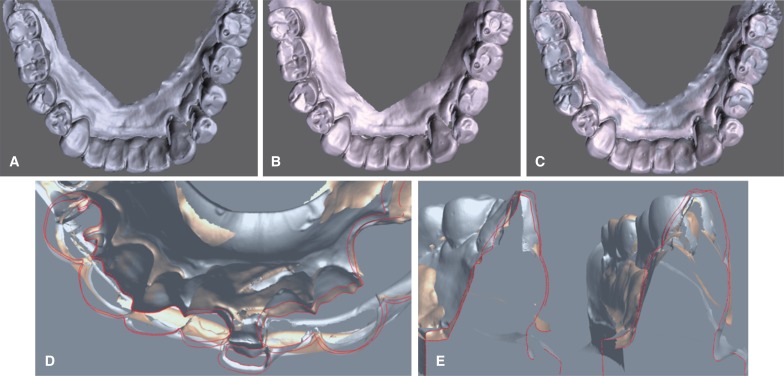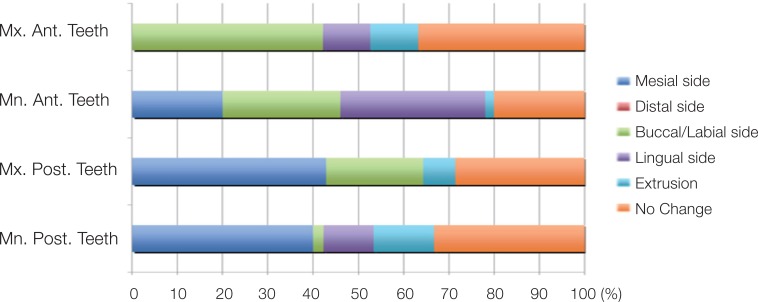J Adv Prosthodont.
2019 Apr;11(2):88-94. 10.4047/jap.2019.11.2.88.
Evaluation of adjacent tooth displacement in the posterior implant restoration with proximal contact loss by superimposition of digital models
- Affiliations
-
- 1Department of Prosthodontics, Seoul National University Bundang Hospital, Seongnam, Republic of Korea.
- 2Department of Oral & Maxillofacial Surgery, Seoul National University Bundang Hospital, Seongnam, Dental Research Institute, School of Dentistry, Seoul National University, Seoul, Republic of Korea.
- 3Department of Prosthodontics, Seoul National University Bundang Hospital, Seongnam, Dental Research Institute, School of Dentistry, Seoul National University, Seoul, Republic of Korea. navydent@snubh.org
- KMID: 2444142
- DOI: http://doi.org/10.4047/jap.2019.11.2.88
Abstract
- PURPOSE
This study was conducted to investigate patterns of adjacent tooth displacement in the posterior implant with interproximal contact loss (ICL) by 3-D digital superimposition method.
MATERIALS AND METHODS
Posterior partially edentulous patients, restored with implant fixed partial prostheses before 2011 and suffered from food impaction of ICL between 2009 and 2011, were included. Two dental casts, at the time of delivery and at the time of food impaction in a same patient, was converted into 3-D digital models through scanning and superimposition was performed to assess chronologic changes of the dentition. Directions of tooth displacement were evaluated and the amount of ICL was calculated. Correlations between the amount of ICL and elapsed time, or between the amount of ICL and age after function, were assessed at a significance level of P<.05.
RESULTS
A total number of 13 patients (8 males, 5 females) with a mean age of 65.76 ± 9.94 years and 17 areas (4 maxillae, 13 mandibles) were included in this retrospective study. Teeth adjacent to the implant restoration showed complex displacements but characteristic tendency according to the location of the arch. The mean amount of ICL was 0.33 ± 0.14 mm. Elapsed time from function to ICL was 61.47 ± 31.27 months. There were no significant differences between the amount of ICL and elapsed time, or age (P>.05).
CONCLUSION
Natural teeth showed various directional movements to result in occlusal change in the arch. The 3-D superimposition of chronologic digital models was a helpful method to analyze the changes of dentition and individual tooth displacement adjacent to implant restoration.
Keyword
MeSH Terms
Figure
Reference
-
1. Blanes RJ, Bernard JP, Blanes ZM, Belser UC. A 10-year prospective study of ITI dental implants placed in the posterior region. II: Influence of the crown-to-implant ratio and different prosthetic treatment modalities on crestal bone loss. Clin Oral Implants Res. 2007; 18:707–714. PMID: 17697000.
Article2. Lekholm U, Gunne J, Henry P, Higuchi K, Lindén U, Bergström C, van Steenberghe D. Survival of the Brånemark implant in partially edentulous jaws: a 10-year prospective multicenter study. Int J Oral Maxillofac Implants. 1999; 14:639–645. PMID: 10531735.3. Naert I, Koutsikakis G, Duyck J, Quirynen M, Jacobs R, van Steenberghe D. Biologic outcome of implant-supported restorations in the treatment of partial edentulism. part I: a longitudinal clinical evaluation. Clin Oral Implants Res. 2002; 13:381–389. PMID: 12175375.4. Goodacre CJ, Kan JY, Rungcharassaeng K. Clinical complications of osseointegrated implants. J Prosthet Dent. 1999; 81:537–552. PMID: 10220658.
Article5. Göthberg C, Bergendal T, Magnusson T. Complications after treatment with implant-supported fixed prostheses: a retrospective study. Int J Prosthodont. 2003; 16:201–207. PMID: 12737255.6. Kim Y, Oh TJ, Misch CE, Wang HL. Occlusal considerations in implant therapy: clinical guidelines with biomechanical rationale. Clin Oral Implants Res. 2005; 16:26–35. PMID: 15642028.
Article7. Pjetursson BE, Lang NP. Prosthetic treatment planning on the basis of scientific evidence. J Oral Rehabil. 2008; 35:72–79. PMID: 18181936.
Article8. Wei H, Tomotake Y, Nagao K, Ichikawa T. Implant prostheses and adjacent tooth migration: preliminary retrospective survey using 3-dimensional occlusal analysis. Int J Prosthodont. 2008; 21:302–304. PMID: 18717086.9. Koori H, Morimoto K, Tsukiyama Y, Koyano K. Statistical analysis of the diachronic loss of interproximal contact between fixed implant prostheses and adjacent teeth. Int J Prosthodont. 2010; 23:535–540. PMID: 21209989.10. Byun SJ, Heo SM, Ahn SG, Chang M. Analysis of proximal contact loss between implant-supported fixed dental prostheses and adjacent teeth in relation to influential factors and effects. A cross-sectional study. Clin Oral Implants Res. 2015; 26:709–714. PMID: 24712313.
Article11. Varthis S, Randi A, Tarnow DP. Prevalence of interproximal open contacts between single-implant restorations and adjacent teeth. Int J Oral Maxillofac Implants. 2016; 31:1089–1092. PMID: 27632264.
Article12. Varthis S, Tarnow DP, Randi A. Interproximal open contacts between implant restorations and adjacent teeth. Prevalence - causes - possible solutions. J Prosthodont. 2019; 28:e806–e810. PMID: 30350332.
Article13. Downs M. Mesial drift. Angle Orthod. 1938; 8:77–99.14. Trauner F. The causes of progressive movement of the teeth toward the front. Am Orthod. 1912; 3:144–158.16. Southard TE, Behrents RG, Tolley EA. The anterior component of occlusal force. Part 1. Measurement and distribution. Am J Orthod Dentofacial Orthop. 1989; 96:493–500. PMID: 2589259.
Article17. Herber RP, Fong J, Lucas SA, Ho SP. Imaging an adapted dentoalveolar complex. Anat Res Int. 2012; 2012:782571. PMID: 22567314.
Article18. Ten Cate AR, Deporter DA, Freeman E. The role of fibroblasts in the remodeling of periodontal ligament during physiologic tooth movement. Am J Orthod. 1976; 69:155–168. PMID: 1061506.19. Proffit WR, Fields HW, Sarver DM. Contemporary orthodontics. 5th ed. St. Louis: Mosby Elsevier;2014. p. 278.20. Thilander B, Odman J, Jemt T. Single implants in the upper incisor region and their relationship to the adjacent teeth. An 8-year follow-up study. Clin Oral Implants Res. 1999; 10:346–355. PMID: 10551059.
Article21. Jemt T. Measurements of tooth movements in relation to single-implant restorations during 16 years: a case report. Clin Implant Dent Relat Res. 2005; 7:200–208. PMID: 16336911.
Article22. Roberts WE, Smith RK, Zilberman Y, Mozsary PG, Smith RS. Osseous adaptation to continuous loading of rigid endosseous implants. Am J Orthod. 1984; 86:95–111. PMID: 6589962.
Article23. Bernard JP, Schatz JP, Christou P, Belser U, Kiliaridis S. Long-term vertical changes of the anterior maxillary teeth adjacent to single implants in young and mature adults. A retrospective study. J Clin Periodontol. 2004; 31:1024–1028. PMID: 15491321.
Article24. Cha BK, Lee JY, Jost-Brinkmann PG, Yoshida N. Analysis of tooth movement in extraction cases using three-dimensional reverse engineering technology. Eur J Orthod. 2007; 29:325–331. PMID: 17513876.
Article25. Hoggan BR, Sadowsky C. The use of palatal rugae for the assessment of anteroposterior tooth movements. Am J Orthod Dentofacial Orthop. 2001; 119:482–488. PMID: 11343019.
Article26. Choi JI, Cha BK, Jost-Brinkmann PG, Choi DS, Jang IS. Validity of palatal superimposition of 3-dimensional digital models in cases treated with rapid maxillary expansion and maxillary protraction headgear. Korean J Orthod. 2012; 42:235–241. PMID: 23173116.
Article27. Bishara SE, Treder JE, Jakobsen JR. Facial and dental changes in adulthood. Am J Orthod Dentofacial Orthop. 1994; 106:175–186. PMID: 8059754.
Article28. Kaplan P. Drifting, tipping, supraeruption, and segmental alveolar bone growth. J Prosthet Dent. 1985; 54:280–283. PMID: 3863937.
Article29. Craddock HL. Occlusal changes following posterior tooth loss in adults. Part 3. A study of clinical parameters associated with the presence of occlusal interferences following posterior tooth loss. J Prosthodont. 2008; 17:25–30. PMID: 17927736.
Article30. Ito H, Okimoto K, Mizumori T, Terada Y, Maruyama T. A clinical study of the relationship between occlusal curvature and craniomandibular disorders. Int J Prosthodont. 1997; 10:78–82. PMID: 9484074.31. Sakaguchi K, Uehara S, Yagi T, Miyawaki S. Relationship between occlusal curvatures and bite force in humans. Orthod Wave. 2012; 71:79–84.
Article32. Brunsvold MA. Pathologic tooth migration. J Periodontol. 2005; 76:859–866. PMID: 15948679.
Article33. Pang NS, Suh CS, Kim KD, Park W, Jung BY. Prevalence of proximal contact loss between implant-supported fixed prostheses and adjacent natural teeth and its associated factors: a 7-year prospective study. Clin Oral Implants Res. 2017; 28:1501–1508. PMID: 28391648.
Article34. Carter GA, McNamara JA Jr. Longitudinal dental arch changes in adults. Am J Orthod Dentofacial Orthop. 1998; 114:88–99. PMID: 9674686.
Article35. Harris EF. A longitudinal study of arch size and form in untreated adults. Am J Orthod Dentofacial Orthop. 1997; 111:419–427. PMID: 9109587.
Article36. Sinclair PM, Little RM. Maturation of untreated normal occlusions. Am J Orthod. 1983; 83:114–123. PMID: 6572039.
Article37. Wong AT, Wat PY, Pow EH, Leung KC. Proximal contact loss between implant-supported prostheses and adjacent natural teeth: a retrospective study. Clin Oral Implants Res. 2015; 26:e68–e71. PMID: 25914905.
Article38. Quimby ML, Vig KW, Rashid RG, Firestone AR. The accuracy and reliability of measurements made on computer-based digital models. Angle Orthod. 2004; 74:298–303. PMID: 15264638.39. Mullen SR, Martin CA, Ngan P, Gladwin M. Accuracy of space analysis with emodels and plaster models. Am J Orthod Dentofacial Orthop. 2007; 132:346–352. PMID: 17826603.
Article40. Miller RJ, Kuo E, Choi W. Validation of Align Technology's Treat III digital model superimposition tool and its case application. Orthod Craniofac Res. 2003; 6:143–149.
- Full Text Links
- Actions
-
Cited
- CITED
-
- Close
- Share
- Similar articles
-
- Long-term follow-up of posterior implant restorations showing under-occlusion: a superimposition analysis of dentition change
- Influence of the adjacent periodontium and inter-implant distance on bone resorption around non-submerged implants: A retrospective clinical and radiographic study
- Sinus floor elevation and implant-supported fixed dental prosthesis in the posterior area, with full-digital system: a case report
- Factors influencing proximal contact loss between fixed implant prostheses and adjacent natural teeth: a retrospective study
- Axial displacement in single-tooth implant restoration: Case report




